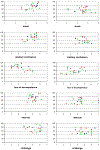An auditory brain-computer interface (BCI)
- PMID: 17399797
- PMCID: PMC7955811
- DOI: 10.1016/j.jneumeth.2007.02.009
An auditory brain-computer interface (BCI)
Abstract
Brain-computer interfaces (BCIs) translate brain activity into signals controlling external devices. BCIs based on visual stimuli can maintain communication in severely paralyzed patients, but only if intact vision is available. Debilitating neurological disorders however, may lead to loss of intact vision. The current study explores the feasibility of an auditory BCI. Sixteen healthy volunteers participated in three training sessions consisting of 30 2-3 min runs in which they learned to increase or decrease the amplitude of sensorimotor rhythms (SMR) of the EEG. Half of the participants were presented with visual and half with auditory feedback. Mood and motivation were assessed prior to each session. Although BCI performance in the visual feedback group was superior to the auditory feedback group there was no difference in performance at the end of the third session. Participants in the auditory feedback group learned slower, but four out of eight reached an accuracy of over 70% correct in the last session comparable to the visual feedback group. Decreasing performance of some participants in the visual feedback group is related to mood and motivation. We conclude that with sufficient training time an auditory BCI may be as efficient as a visual BCI. Mood and motivation play a role in learning to use a BCI.
Figures




References
-
- Averbeck M, Leiberich P, Grote-Kusch MT, Olbrich E, Schröder A, Brieger M, Schumacher K. Skalen zur Erfassung der Lebensqualität (SEL) – Manual. Swets & Zeitlinger B.V.: Frankfurt, 1997.
-
- Bach JR. Amyotrophic lateral sclerosis - communication status and survival with ventilatory support. Am. J. Physical Med. Rehabil, 1993; 72: 343–49. - PubMed
-
- Birbaumer N, Ghanayim N, Hinterberger T, Iversen I, Kotchoubey B, Kübler A, Perelmouter J, Taub E, Flor H. A spelling device for the paralysed. Nature, 1999; 398: 297–8. - PubMed
-
- Birbaumer N Breaking the silence: brain-computer interfaces (BCI) for communication and motor control. Psychophysiology, 2006; 43: 517–37. - PubMed
Publication types
MeSH terms
Substances
Grants and funding
LinkOut - more resources
Full Text Sources

